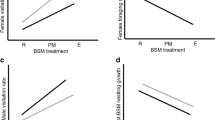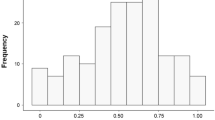Abstract
We estimated the reproductive success of black terns (Chlidonias niger) based on three optimal foraging currencies (maximizing the net rate of energy intake, daily delivery rate, and efficiency, respectively) and a state variable model. There was a broad range of capture intervals (the time required for the parent to capture a single prey) when the flight speeds predicted by the three currencies were so high that they resulted in daily provisioning costs which parents could not fully recover through self-feeding. Whenever the efficiency currency produced higher estimates of reproductive success, parents lost comparatively less weight than when they foraged as rate-maximizers. If parents did not experience any weight loss, the net rate and efficiency currencies made equivalent fitness projections. However, both of these currencies provided lower fitness returns than daily delivery rate at longer capture intervals. There were a number of capture intervals when estimates of reproductive success from the state variable model and at least one of the foraging currencies were equal. Provisioning behaviour under the state variable model was much more flexible and parents were therefore able to reduce their self-feeding rate on days when food was particularly scarce, thereby increasing the total delivery to the nest. This resulted in higher fitness returns than was possible under the foraging currencies. Our results suggest that efficiency-maximizing is more likely to provide fitness returns that are equivalent to the state variable model in comparison with the rate-maximizing alternatives. Furthermore, only the efficiency currency and the state variable model made predictions of flight speed that were similar to speeds measured in black tern parents provisioning young at natural nests.
Similar content being viewed by others
References
Beauchamp, G., Ens, B.J. and Kacelnik, A. (1991) A dynamic model of food allocation to starling (Sturnus vulgaris) nestlings. Behav. Ecol. 2, 21–37.
Carlson, A. and Moreno, J. (1982) The loading effect in central place foraging Wheatears (Oenanthe oenanthe L.). Behav. Ecol. Sociobiol. 11, 173–183.
Clark, C.W. (1991) Modeling behavioral adaptations. Beh. Brain Sci. 14, 85–117.
Clark, C.W. and Ydenberg, R.C. (1990) The risks of parenthood. I. General theory and applications. Evol. Ecol. 4, 21–34.
Cramp, S. (1985) The Birds of the Western Palearctic. Oxford University Press, Oxford.
Drent, R. and Klaassen, M. (1990) Energetics of avian growth: The causal link with BMR and metabolic scope. In Physiology of Cold Adaptation in Birds (C. Bech and R.E. Reinertsen, eds), pp. 349–359. Plenum Press, New York.
Dunn, E.H. (1979) Nesting biology and development of young in Ontario black terns. Can. Field-Nat. 93, 276–281.
Henny, C.J. (1972) An Analysis of Population Dynamics of Selected Avian Species. US Department of the Interior, Wildlife Research Report 1.
Houston, A.I. (1987) Optimal foraging by parent birds feeding dependent young. J. Theor. Biol. 124, 251–274.
Houston, A.I. and McNamara, J. (1985) The choice of two prey types that minimizes the probability of starvation. Behav. Ecol. Sociobiol. 17, 135–141.
Houston, A.I. and McNamara, J. (1988) A framework for the functional analysis of behaviour. Beh. Brain Sci. 11, 117–163.
Kacelnik, A. (1984) Central place foraging in starlings (Sturnus vulgaris). I. Patch residence time. J. Anim. Ecol. 53, 283–299.
Kacelnik, A., Houston, A.I. and Schmid-Hempel, P. (1986) Central-place foraging in honeybees: The effect of travel time and nectar flow on crop filling. Behav. Ecol. Sociobiol. 19, 19–24.
Kendeigh, S.C., Dol'nik, V.R. and Gavrilov, V.M. (1977) Avian energetics. In Granivorous Birds in Ecosystems (J. Pinowski and S.C. Kendeigh, eds), pp. 127–204. Cambridge University Press, Cambridge.
Kirkwood, J.K. (1983) A limit to metabolisable energy intake in mammals and birds. Comp. Biochem. Physiol. 75A, 1–3.
Krebs, J.R., Stephens, D.W. and Charnov, E.L. (1983) Perspectives in optimal foraging. In Perspectives in Ornithology (A.H. Brush and G.A. Clark, eds), pp. 165–216. Cambridge University Press, Cambridge.
Mangel, M. (1992) Rate maximizing and state variable theories of diet selection. Bull. Math. Biol. 54, 413–422.
Mangel, M. and Clark, C.W. (1988) Dynamic Modeling in Behavioral Ecology. Princeton University Press, Princeton, NJ.
Mangel, M. and Ludwig, D. (1992) Definition and evaluation of the fitness of behavioral and developmental programs. Ann. Rev. Ecol. Syst. 23, 507–536.
McLaughlin, R.L. and Montgomerie, R.D. (1985) Flight speeds of central place foragers: Female Lapland longspurs feeding nestlings. Anim. Behav. 33, 810–816.
McLaughlin, R.L. and Montgomerie, R.D. (1990) Flight speeds of parent birds feeding nestlings: Maximization of foraging efficiency or food delivery rate? Can. J. Zool. 68, 2269–2274.
Mosher, B.C. (1986) Factors influencing reproductive success and nesting strategies in black terns. PhD thesis. Simon Fraser University, Vancouver, BC.
Orians, G.H. and Pearson, N.E. (1979) On the theory of central place foraging. In Analysis of Ecological Systems (D.J. Horn, G.R. Stairs and R.D. Mitchell, eds), pp. 155–177. Ohio State University Press, Columbus, OH.
Oster, G. (1976) Modeling social insect populations. I. Ergonomics of foraging and population growth in bumblebees. Am. Nat. 110, 215–245.
Pennycuick, C.J. (1975) Mechanics of bird flight. In Avian Biology, Vol. 5 (D.S. Farner and J.R. King, eds), pp. 1–74. Academic Press, New York.
Pennycuick, C.J. (1989) Bird Flight Performance. Oxford University Press, Oxford.
Schmid-Hempel, P. (1987) Efficient nectar-collecting by honeybees. I. Economic models. J. Anim. Ecol. 56, 209–218.
Schmid-Hempel, P., Kacelnik, A. and Houston, A.I. (1985) Honybees maximize efficiency by not filling their crop. Behav. Ecol. Sociobiol. 17, 61–66.
Stephens, D.W. and Krebs, J.R. (1986) Foraging Theory. Princeton University Press, Princeton, NJ.
Tinbergen, J.M. (1981) Foraging decisions in starlings (Sturnus vulgaris L.). Ardea 69, 1–67.
Waite, T.A. and Ydenberg, R.C. (1994) Shift towards efficiency-maximizing by grey jays hoarding in winter. Anim. Behav. 48, 1466–1468.
Weiner, J. (1992) Physiological limits to sustainable energy budgets in birds and mammals: Ecological implications. Trends Ecol. Evol. 7, 384–388.
Welham, C.V.J. and Ydenberg, R.C. (1988) Net energy versus efficiency maximizing by foraging ring-billed gulls. Behav. Ecol. Sociobiol. 23, 75–82.
Welham, C.V.J. and Ydenberg, R.C. (1993) Efficiency-maximizing flight speeds in parent black terns. Ecology 74, 1893–1901.
Ydenberg, R.C., Welham, C.V.J., Schmid-Hempel, R., Schmid-Hempel, P. and Beauchamp, G. (1994) Time and energy constraints and the relationships between currencies in foraging theory. Behav. Ecol. 5, 28–34.
Author information
Authors and Affiliations
Rights and permissions
About this article
Cite this article
Welham, C.V., Beauchamp, G. Parental provisioning in a variable environment: Evaluation of three foraging currencies and a state variable model. Evolutionary Ecology 11, 399–417 (1997). https://doi.org/10.1023/A:1018480723094
Issue Date:
DOI: https://doi.org/10.1023/A:1018480723094




